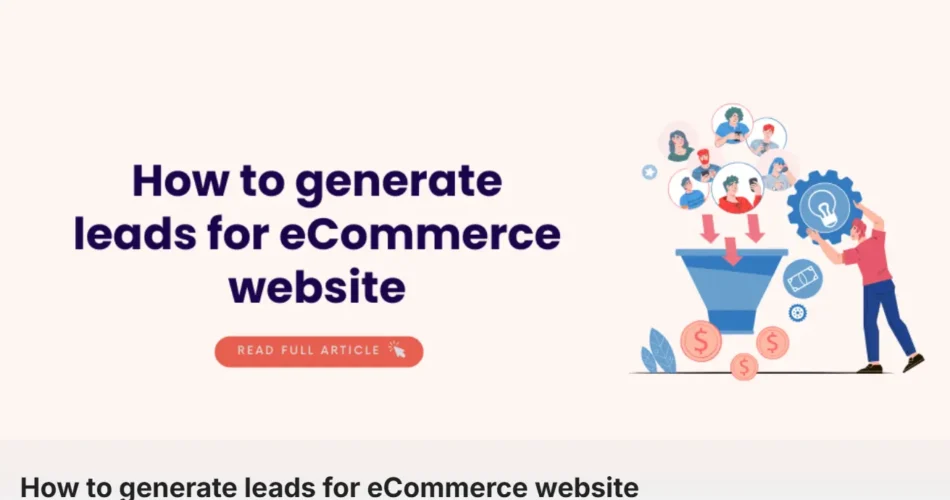In today’s competitive digital marketplace, generating eCommerce leads is essential for business growth. Whether you run a small online store or a large-scale eCommerce brand, having a steady stream of potential customers can significantly impact your sales. But how do you attract, capture, and convert leads into paying customers?
In this guide, we’ll explore the best strategies to generate eCommerce leads, covering SEO, content marketing, social media, paid ads, and more. Let’s dive in!
Contents
- 1 What Are eCommerce Leads?
- 2 1. Optimize Your Website for Lead Generation
- 3 2. Leverage SEO to Attract Organic Traffic
- 4 3. Content Marketing for Lead Generation
- 5 4. Social Media Strategies to Generate eCommerce Leads
- 6 5. Email Marketing for Lead Nurturing
- 7 6. Paid Advertising to Generate Fast eCommerce Leads
- 8 7. Use Retargeting Strategies
- 9 8. Affiliate and Referral Marketing
- 10 9. Leverage Chatbots and AI
- 11 10. Track and Analyze Your Lead Generation Performance
- 12 Conclusion
What Are eCommerce Leads?

eCommerce leads are potential customers who have shown interest in your online store but haven’t made a purchase yet. They may have signed up for your newsletter, added products to their cart, or downloaded a free resource. The goal is to nurture these leads until they convert into buyers.
1. Optimize Your Website for Lead Generation
a) Improve Your Website Speed and UX
A slow website can drive visitors away before they even explore your products. Use tools like Google PageSpeed Insights to analyze and improve your site’s performance.
b) Use Lead Capture Forms
Offer incentives like discounts or free guides in exchange for visitor emails. Place forms strategically on your homepage, product pages, and blog posts.
c) Implement Exit-Intent Popups
Exit-intent popups appear when users are about to leave your site, encouraging them to subscribe or grab a last-minute deal.
2. Leverage SEO to Attract Organic Traffic
Search engine optimization (SEO) is one of the best long-term strategies for attracting quality eCommerce leads. Here’s how:
a) Perform Keyword Research
Use tools like Ahrefs, SEMrush, or Google Keyword Planner to find high-intent keywords related to your products.
b) Optimize Product Pages
- Use keyword-rich titles and meta descriptions.
- Write unique, compelling product descriptions.
- Add high-quality images and videos.
c) Create SEO-Optimized Content
Start a blog and publish valuable content that answers customer queries. Examples:
- “The Best Running Shoes for Beginners”
- “How to Choose the Right Skincare Products for Your Skin Type”
3. Content Marketing for Lead Generation
a) Create Valuable Blog Posts
Educational content positions your brand as an authority and attracts potential leads.
b) Offer Lead Magnets
Provide free resources such as:
- eBooks
- Discount codes
- Webinars
- Free shipping for first-time buyers
c) Use Video Marketing
Videos improve engagement and conversions. Create product demos, testimonials, or explainer videos.
4. Social Media Strategies to Generate eCommerce Leads
a) Leverage Facebook and Instagram Ads
Run highly targeted ad campaigns to reach your ideal customers.
b) Use Shoppable Posts
Platforms like Instagram and Facebook allow users to buy directly from posts, reducing friction in the sales process.
c) Partner with Influencers
Work with niche influencers to promote your products and generate leads through their audience.
d) Engage in Social Media Communities
Join Facebook groups, Reddit discussions, or Quora threads related to your industry to establish credibility and attract leads.
5. Email Marketing for Lead Nurturing
Once you capture eCommerce leads, nurture them through email campaigns.
a) Set Up Welcome Emails
When someone subscribes, send a warm welcome email with a discount or a valuable resource.
b) Segment Your Email List
Personalize your emails based on customer behavior. For example:
- First-time visitors → Welcome offer
- Cart abandoners → Reminder emails with discounts
- Repeat customers → Loyalty rewards
c) Automate Follow-Ups
Use email automation tools like Klaviyo, Mailchimp, or ConvertKit to send timely messages.
6. Paid Advertising to Generate Fast eCommerce Leads
If you want quick results, consider running paid campaigns.
a) Google Ads
Run Google Search Ads targeting high-intent keywords like “buy [product name] online.” Use Google Shopping Ads to showcase products visually.
b) Facebook and Instagram Ads
- Use retargeting ads to bring back visitors who didn’t convert.
- Run carousel ads to showcase multiple products.
c) TikTok Ads
If your target audience is younger, leverage TikTok ads to reach a highly engaged audience.
7. Use Retargeting Strategies
a) Facebook Pixel and Google Remarketing
Install tracking pixels on your site to retarget visitors with relevant ads after they leave your store.
b) Send Cart Abandonment Emails
Remind users about their abandoned carts and offer a discount to encourage them to complete the purchase.
8. Affiliate and Referral Marketing
a) Set Up an Affiliate Program
Encourage bloggers and influencers to promote your products in exchange for a commission.
b) Launch a Referral Program
Offer customers discounts or rewards when they refer friends.
9. Leverage Chatbots and AI
a) Use Chatbots for Engagement
AI chatbots like Tidio or Drift can answer FAQs and guide visitors toward making a purchase.
b) Implement Live Chat
Live chat support can boost lead conversion rates by addressing customer concerns in real-time.
10. Track and Analyze Your Lead Generation Performance
a) Use Google Analytics
Track where your leads are coming from and optimize your campaigns accordingly.
b) A/B Test Your Strategies
Experiment with different lead magnets, landing pages, and CTAs to see what works best.
Conclusion
Generating eCommerce leads requires a mix of organic and paid strategies. From SEO, content marketing, social media, and email marketing to paid ads and chatbots, every method plays a crucial role in attracting potential customers.
The key is to provide value, optimize your website, and engage with potential leads at every touchpoint. By implementing these strategies, you can build a strong pipeline of high-converting eCommerce leads and grow your online store exponentially.
